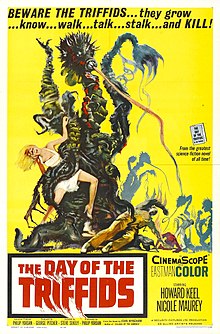|
The Day of the Triffids (film)
The Day of the Triffids is a 1963 British science fiction horror film in CinemaScope and Eastmancolor, produced by George Pitcher and Philip Yordan and directed by Steve Sekely.[2] It stars Howard Keel and Nicole Maurey and is loosely based on the 1951 novel of the same name by John Wyndham. The film was released in the UK by the Rank Organisation and in the US by Allied Artists. PlotA meteor shower blinds most people in the world and at the same time spreads triffid plant spores, which quickly become animated. Bill Masen, a merchant navy officer who has been in hospital overnight with his eyes bandaged, is unaffected and leaves the next day. While at a railway station he comes across an orphaned schoolgirl named Susan who, having spent the night in the luggage van of a train, is unaffected too. He helps her escape the groping crowds and they commandeer an abandoned car in order to reach his ship. On their way the car gets stuck in mud and while they look for stones to gain traction a mobile triffid ambushes them and they barely escape. Meanwhile, scientist Tom Goodwin and his wife Karen have been isolated in a lighthouse and learn of the world emergency only over the radio. Karen alerts Tom to a triffid growing on a ledge; they leave the door open, it gets in and Tom has to battle it off. Though it appears dead, they discover that triffids can apparently regenerate themselves. The couple then barricade themselves in and set to work to discover some means of neutralising the plants. After Masen and Susan finally make it to the dockyard, they only hear bad news from over the radio. They then cross by boat into France, where they come across Christine Durant at a roadblock. She guides them to a château, which is serving as a refuge for the blind. While looking for supplies at a grocery store with Mr Coker, a worker at the castle, they discover dozens of the plants and Coker is killed by one while they are returning to the chateau to warn the others. Later the place is invaded by escaped convicts and during the mayhem triffids move in and kill everyone except Bill, Susan and Christine, who manage to get away in the prison bus. After discovering that Toulon is in flames, Masen next heads for the American naval base in Cádiz. On their way they encounter a blind couple, Luis de la Vega and his pregnant wife, Teresa, and help her deliver a baby boy. Luis tells Masen that the Cadiz base has been evacuated by submarine since those who were underwater didn't get blinded by the meteor shower. Masen gets de Vega's radio transmitter working just in time to hear the navy broadcasting a message about a final survivor pickup in Alicante the next day and a warning to beware of wandering bands of triffids. The group decides to leave early in the morning and Masen electrifies the enclosing fence around the villa during the night as a precaution. When triffids arrive the current is too weak to hold them off for long and Masen has to improvise a flamethrower from a fuel truck to keep them off. He also realizes that the triffids are attracted to sound, so he decoys them next morning with a musical clown car while the others escape. He himself manages to attract the attention of a naval dinghy, which picks him up and takes him to the submarine. Back at the lighthouse the triffids manage to break in and Tom and Karen retreat to the top of the stairs. In a last effort to hold them off Tom sprays them with a salt-water fire hose and the triffids begin to dissolve in a cloud of green smoke. Tom realizes that sea water is the answer they have been looking for all along and uses the hose to kill the rest of the triffids in the lighthouse. At the end the narrator states that humanity has conquered the triffids by turning to the very thing that gave humans life in the beginning: sea water. Meanwhile the people from the submarine have disembarked and are heading up to a church to give thanks for their survival. Cast
Reception Although the film retained some basic plot elements from Wyndham's novel, it is not a particularly faithful adaptation: "It strays significantly and unnecessarily from the book and is less well regarded than the BBC's intelligent (if dated) 1981 TV serial".[3] Unlike in the novel the triffids arrive from a meteor shower, some of the action is moved to France and Spain, and an important character, Josella Playton, is deleted.[4] Most seriously, the screenplay supplies a simplistic solution to the triffid problem: salt water dissolves them and "the world was saved".[5] Simon Clark, author of The Night of the Triffids, stated in an interview:
Halliwell's Film Guide claimed the film was a "rough and ready adaptation of a famous sci-fi novel, sometimes blunderingly effective and with moments of good trick work".[7] At the film review aggregator website Rotten Tomatoes, the film holds an approval rating of 79% based on 19 reviews, with a weighted average rating of 6.4/10.[8] See also
References
Bibliography
External linksWikimedia Commons has media related to The Day of the Triffids. Wikiquote has quotations related to The Day of the Triffids (film). |
||||||||||||||||||||||||||||||
